Bai Dinh Pagoda, a renowned spiritual tourism symbol in Ninh Binh, is always an attractive destination for visitors from everywhere, especially during the spring season. Not only is it the largest pagoda complex in Southeast Asia, but Bai Dinh also holds profound historical and cultural values, along with unique architecture that blends ancient and modern features. Let’s explore the most detailed Bai Dinh Pagoda travel guide to have a complete and meaningful journey in this ancient capital land.
Discover Bai Dinh Pagoda: From History to Unique Architecture
Where is Bai Dinh Pagoda in Ninh Binh?
Located on Bai Dinh mountain in Gia Sinh commune, Gia Vien district, Bai Dinh Pagoda majestically sits amidst the picturesque landscape of Ninh Binh. This location is about 97km from the center of Hanoi, 5km northwest of the ancient capital of Hoa Lu, and 12km from Ninh Binh city. With a total area of 539 hectares, Bai Dinh Pagoda is divided into the ancient pagoda area (27 hectares) imbued with historical imprints and the new pagoda area (80 hectares) showcasing the grandeur and magnificence of contemporary Buddhist architecture. The harmonious combination of spiritual space and natural scenery has transformed Bai Dinh into a must-visit destination when coming to Ninh Binh. Annually, Bai Dinh Pagoda welcomes millions of Buddhist followers and tourists, becoming a major pilgrimage center and an ideal spring travel destination.
The Historical Formation of Bai Dinh Pagoda Through Dynasties
Bai Dinh Pagoda carries within it a historical depth of over 1000 years, associated with important milestones of the nation. This place witnessed the flourishing of Buddhism under the Dinh, Early Le, and Ly dynasties in the Hoa Lu capital. From the Dinh dynasty, Bai Dinh Pagoda was formed on the Trang An mountain range, considered a land of spiritual significance and outstanding individuals, converging the sacred energy of rivers and mountains.

Legend has it that Bai Dinh mountain was once where Emperor Dinh Tien Hoang performed rituals to pray for national peace and prosperity, favorable weather, and abundant harvests. By the time of King Quang Trung, this place was chosen as the site for a flag-raising ceremony, encouraging soldiers before advancing to Thang Long to expel the Qing invaders. In 1997, Bai Dinh Pagoda was honored to be recognized as a national historical, cultural, and revolutionary relic, affirming the great position and value of the pagoda in Vietnamese history and culture. To this day, Bai Dinh Pagoda is not only a spiritual destination but also a place for visitors to learn about the heroic history of the nation.
Bai Dinh Pagoda Architecture: Harmony Between Classic and Modern
The Bai Dinh Pagoda complex today includes the ancient pagoda area and the new pagoda area, each with its own unique architectural beauty but still harmonious in the overall picture. The ancient pagoda area, existing for over 1000 years, retains its original, ancient, and serene architectural features. Meanwhile, the new pagoda area, built from 2003, impresses with its grandeur, magnificence, and large-scale Buddhist architectural works. Bai Dinh Pagoda resembles a beautiful feng shui painting, backing against the mountain, facing the lake, surrounded by majestic limestone mountains, creating a space that is both sacred and poetic.
A highlight in Bai Dinh Pagoda’s architecture is the main hall’s roof with a 3-tiered, 12-curved roof style, covered with traditional “mui hai” tiles, bearing the deep imprint of Vietnamese architecture. The pagoda’s doorstep steps are intricately carved with stone dragons in the Ly dynasty style, expressing majesty and power. The large stone courtyard leading down to the Ngoc (Jade) Well creates an open, airy space and carries distinctive feng shui elements.
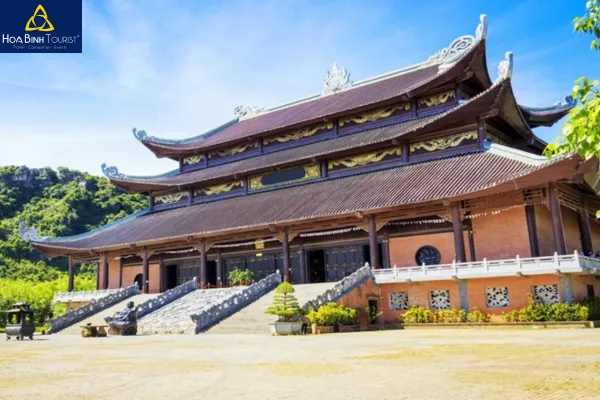
Stepping into Bai Dinh Pagoda, visitors will feel a peaceful, cool space with the nearly 3km long Arhat corridor, with 500 Arhat statues carved from blue stone on both sides. The lush green gardens with many precious trees, especially 100 Bodhi trees grafted from the Indian Bodhi tree, further enhance the serene beauty of the pagoda. Bai Dinh Pagoda is not only famous for its architecture and history but also holds many Asian and Vietnamese records, affirming its position as one of the largest and most beautiful pagodas in the region.
Impressive records of Bai Dinh Pagoda:
- Largest gold-plated bronze Buddha statue in Asia (statue in the Dharma Lord Palace).
- Largest bronze Maitreya Buddha statue in Southeast Asia (outdoor statue).
- Largest bronze bell in Vietnam (Great Bell in the Bell Tower).
- Tallest stupa in Asia (Bai Dinh Pagoda Stupa, 13 floors, 100m high).
- Largest pagoda area in Vietnam (total 539 hectares).
- Pagoda with the longest Arhat corridor in Asia (nearly 3 km).
- Pagoda with the most Arhat statues in Vietnam (500 statues).
- Pagoda with the largest Jade Well in Vietnam.
- Pagoda with the most Bodhi trees in Vietnam (100 trees).
Bai Dinh Pagoda Festival: A Unique Spiritual Cultural Feature
Bai Dinh Pagoda Festival is one of the largest spring festivals in Northern Vietnam, taking place from the 1st day of Tet to the end of the 3rd lunar month every year. The festival is the opening event for a series of pilgrimages to the ancient capital of Hoa Lu, attracting a large number of tourists and Buddhist followers to participate. Bai Dinh Pagoda Festival is divided into two main parts: the ceremony part and the festival part.
The ceremony part includes solemn rituals such as:
- Procession ceremony: Procession of palanquins carrying altar tablets of Cao Son God, Saint Nguyen, and Lady Thuong Ngan from the ancient pagoda to the new pagoda.
- Incense offering ceremony: Commemorating the merits of Buddha, Saint Nguyen Minh Khong, Cao Son God, and Mother Thuong Ngan.
- Ritual ceremony: Offering sacrifices to Cao Son God and Mother Thuong Ngan.
The festival part brings a joyful, bustling atmosphere with cultural activities and traditional folk games such as:
- Exploring caves and admiring the pagoda’s scenery.
- Enjoying “cheo” and “xam” singing arts.
- Watching stage performances reenacting Emperor Dinh Tien Hoang’s “Dang Dan Xa Tac” ceremony and King Quang Trung’s flag-raising ceremony.
Bai Dinh Pagoda Festival is not only an occasion to pray for good luck and admire the scenery but also an opportunity for visitors to learn about Vietnamese culture, history, and folk beliefs. The harmonious combination of Buddhism, Mother Goddess worship, and Confucianism has created a unique feature for the festival, attracting visitors from everywhere to worship and experience.
Detailed Bai Dinh Pagoda Travel Guide From A to Z
The Best Time to Travel to Bai Dinh Pagoda
Traveling to Bai Dinh Pagoda in any season brings a unique beauty. However, the ideal time to visit Bai Dinh is in the spring, from January to March of the lunar calendar. At this time, the weather is warm and pleasant, the natural scenery is beautiful, suitable for spring travel, sightseeing, and participating in festivals. In particular, the Bai Dinh Pagoda Festival takes place from January 10th to the end of March of the lunar calendar, bringing visitors many unique cultural and spiritual experiences.

However, spring is also the peak tourist season, with a large number of visitors flocking to Bai Dinh Pagoda, which can cause crowding and noise. If you are looking for peace and quiet, you can choose to go to Bai Dinh Pagoda at other times of the year. From March of the lunar calendar onwards, the weather in Ninh Binh is cool and pleasant, the pagoda space is also quieter, allowing you to comfortably visit, worship, and enjoy the spiritual beauty of Bai Dinh.
Bai Dinh Pagoda Travel Costs: Detailed Budget Estimate
Currently, Bai Dinh Pagoda does not charge entrance fees, and visitors can freely visit the outer areas. However, to fully explore the beauty and vastness of the pagoda complex, you can use some services and visit special spots with costs as follows:
- Electric car ticket: 60,000 VND/person/round trip (30,000 VND/one way). Electric cars help you move quickly and save energy within the large pagoda grounds.
- Bao Thap (Stupa) entrance ticket: 50,000 VND/person. Bao Thap is a unique architectural work where you can admire the panoramic view of Bai Dinh Pagoda and Ninh Binh from above.
- Hire a tour guide: 300,000 – 500,000 VND/tour. A tour guide will help you better understand the history, architecture, and culture of Bai Dinh Pagoda.
- Trang An entrance ticket: 250,000 VND/person (boat tour route). If you have time, you should combine visiting Trang An – a world natural and cultural heritage site, located near Bai Dinh Pagoda.
Estimated total cost for a Bai Dinh Pagoda trip (excluding transportation and food costs): Approximately 200,000 – 500,000 VND/person, depending on your needs and service choices.
The Most Convenient Means of Transportation to Bai Dinh Pagoda
There are many means of transportation for you to choose to get to Bai Dinh Pagoda from Hanoi and other provinces:
- Motorbike: Suitable for young people who like backpacking and want to be proactive with their time. The route from Hanoi to Ninh Binh is quite easy, you can follow National Highway 1A or the Phap Van – Cau Gie expressway.
- Coach: A popular and cost-effective means of transportation. You can take a coach to Ninh Binh from Giap Bat, My Dinh bus stations (Hanoi) with fares ranging from 80,000 – 120,000 VND/person.
- Train: An ideal choice for those who want to enjoy the scenery along the way. Train tickets from Hanoi to Ninh Binh range from 100,000 – 200,000 VND/person, depending on the seat type.
- Private car/car rental: Convenient and comfortable for families or groups of friends. You can drive yourself or rent a private car to get to Bai Dinh Pagoda.
When you arrive at Bai Dinh Pagoda, because the pagoda grounds are very large, you should use electric cars to move between visiting areas.
Preparing Offerings to Go to Bai Dinh Pagoda Properly
To make your trip to Bai Dinh Pagoda more meaningful, you should prepare offerings at home to ensure solemnity and save costs. When preparing offerings, the most important thing is sincerity, not needing to be too elaborate in material things.
Vegetarian offerings: Usually used to worship Buddha, including incense, fresh flowers, ripe fruits, “oan” cakes, sticky rice, sweet soup, vegetarian cakes and candies. Meat offerings: Usually used to worship Saints, Mothers, and Duc Ong, including meat, sausage, spring rolls, sticky rice, chicken, wine. Note that meat offerings should not be placed in the Buddha shrine area. Love prayer offerings: Prepare betel leaves and areca nuts, red roses, cakes and candies, white sticky rice, spring rolls, white wine, votive paper money (placed at the Saint, Mother, Duc Ong altar).
Notes when preparing offerings:
- Do not prepare overly lavish and costly offerings, sincerity is important.
- Do not use votive paper money or ghost money to worship Buddha.
- Real money should be put in the donation box, not placed on the incense table.
- Choose fresh flowers with pure fragrances such as lotus, tuberose, chrysanthemum, peony.
- Dress politely and discreetly when going to the pagoda.
The Most Attractive Tourist Attractions in Bai Dinh Pagoda
Bai Dinh Pagoda is divided into two main areas: the ancient pagoda and the new pagoda, each area has unique attractions:
Ancient Pagoda Area:
- Temple of Saint Nguyen: Dedicated to Zen Master Nguyen Minh Khong, who made great contributions to the construction of Bai Dinh Pagoda and treated the king’s illness. The temple’s architecture is deeply traditional with exquisite carved patterns.
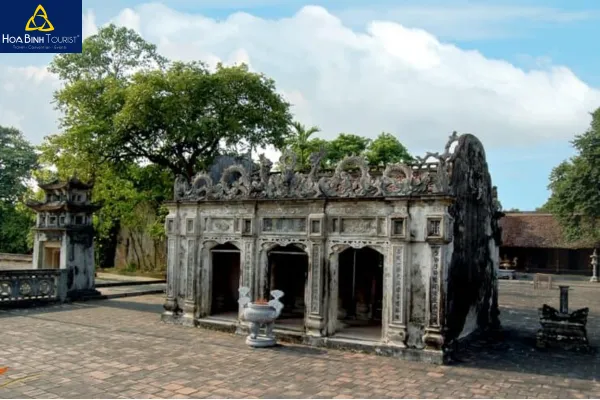
- Sang Cave (Bright Cave) and Toi Cave (Dark Cave): Two natural caves located in Bai Dinh mountain. Sang Cave receives natural light, worshiping Buddha and Cao Son God. Toi Cave is mysterious with a lighting system, worshiping the Mother Goddess and fairies.
- Ngoc Well (Jade Well): The largest natural well in Vietnam, legend has it that it was dug by Zen Master Nguyen Minh Khong, the well water is clear all year round and has healing effects.
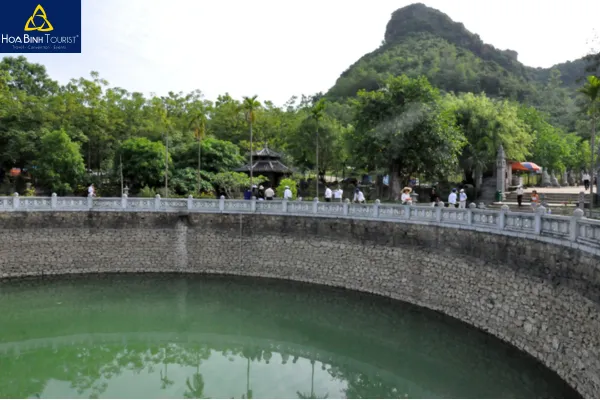
New Pagoda Area:
- Tam The Palace (Palace of the Three Times) and Phap Chu Palace (Dharma Lord Palace): Two massive and magnificent architectural works, places of worship for the Buddhas of the Three Times and Buddha Shakyamuni. Phap Chu Palace stands out with the largest gold-plated bronze Buddha Shakyamuni statue in Asia.
- Bell Tower: A 3-tiered bell tower with architecture mimicking ancient bell towers, hanging the largest Great Bell in Vietnam.
- Maitreya Buddha Statue: The largest bronze Maitreya Buddha statue in Southeast Asia, placed on a high hill, bringing a majestic and magnificent beauty.
- Arhat Corridor: The longest corridor in Asia with 500 Arhat statues carved from blue stone, each statue with a different face and posture, showing the vibrancy of life.
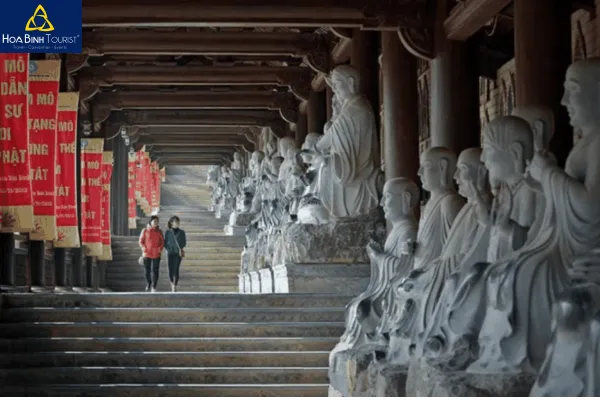
Enjoying the Unique Cuisine of Bai Dinh Pagoda Region
Traveling to Bai Dinh Pagoda is not only a spiritual journey but also an opportunity for you to explore Ninh Binh cuisine with many attractive specialties:
- Com chay (Crispy rice crust): A famous dish of Ninh Binh, made from sticky rice and dry rice, crispy fried, served with pork floss, fried shallots, or goat sauce.
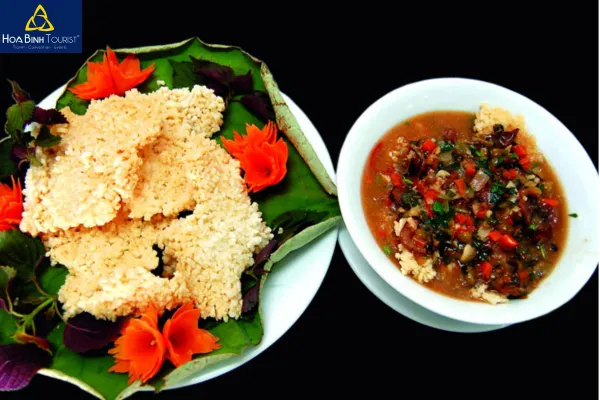
- Mam tep Gia Vien (Gia Vien fermented shrimp paste): A famous specialty of Gia Vien district, Ninh Binh, with a rich, fragrant, and delicious flavor, often used to eat with rice, boiled meat, and raw vegetables.
- Thit de nui (Mountain goat meat): Goats are raised on Ninh Binh rocky mountains, the meat is firm, fragrant, and delicious, processed into many attractive dishes such as goat salad, grilled goat, stir-fried goat.
- Mien luon (Glass noodles with eel): A typical dish of Ninh Binh, with a sweet broth, chewy and delicious eel meat, served with shredded banana flower.
- Oc nui (Mountain snails): A type of snail living in limestone mountain caves, the meat is chewy, crispy, naturally sweet, with a medicinal herb flavor, often processed into steamed, grilled, and stir-fried dishes.
Important Notes for a Complete Bai Dinh Pagoda Trip
- Dress code: Choose polite, discreet clothing, suitable for the spiritual space of the pagoda. Avoid wearing revealing, brightly colored clothes. You should wear comfortable shoes for easy movement.
- Accommodation: If you plan to stay overnight in Ninh Binh, you should book a hotel room in advance, especially during peak tourist season.
- Dining: Choose reputable eateries and restaurants, ensuring food safety and hygiene. Refer to the suggested Ninh Binh specialty restaurant addresses above.
- Maintain general hygiene: Do not litter indiscriminately within the pagoda grounds, keep the landscape green, clean, and beautiful.
- Respect culture and beliefs: Behave in a civilized and polite manner, respect the regulations of the pagoda and local beliefs.
- Be careful with personal belongings: Beware of pickpockets and theft in crowded places.
To have a convenient and meaningful Bai Dinh Pagoda trip, you can refer to package tours from reputable travel companies such as Hoa Binh Tourist. A tour will help you save time and effort in planning, while experiencing professional service and fully exploring the beauty of Bai Dinh Pagoda and Ninh Binh.
Traveling to Bai Dinh Pagoda is not only a journey to explore spiritual beauty but also an opportunity for you to immerse yourself in the nature, culture, and history of the ancient capital of Ninh Binh. Plan your trip today to have memorable experiences at this famous pagoda!